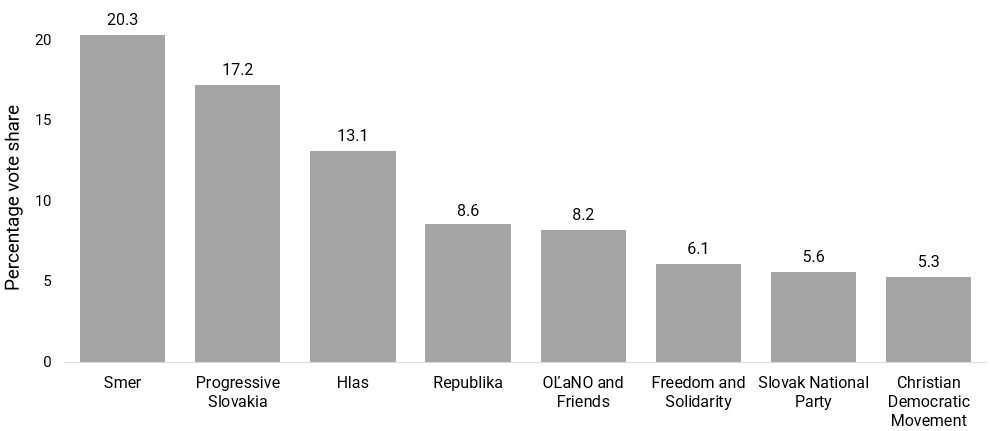Slovakia will hold its next parliamentary election on 30 September. Michael Rossi writes that polling data suggests Robert Fico’s Smer is likely to win the most seats, but coalition-building will depend on cooperation with a breakaway party.
Robert Fico, Slovakia’s long-time power broker and political leader seems poised for an extraordinary comeback in the country’s upcoming parliamentary election. Four years ago, Fico’s party Smer (Direction), was the target of widespread electoral anger against a number of public grievances ranging from endemic corruption, political elitism and ties to organised criminal syndicates. Voters overwhelmingly chose a series of alternative parties, which under the leadership of OL’aNO (Ordinary People and Independent Personalities), formed a governing coalition that removed Smer from power.
At the time, Slovakia seemed to be in the midst of rapid socio-political change; first with the election of Zuzana Čaputová, a liberal progressive, and then with a parliament led by an anti-establishment party that campaigned on an anti-corruption platform. To top it off, Smer underwent an internal revolt from key members of its party who demanded Fico resign as party head, threatening they would break away and form their own party if he did not. Fico refused, members defected and formed a new party, and for a while it seemed that both Fico and Smer would fade into obscurity.
Figure 1: Polling ahead of the 2023 Slovakian parliamentary election
Source: Opinion poll conducted by Ipsos for the Pravda newspaper between 15 and 19 September 2023.
Times have changed and Fico not only continues to lead Smer but has apparently capitalised on several political, economic and social crises afflicting Slovakia. His own political tenacity to keep a core group of supporters, coupled with the organisational weakness of his rivals and continued patterns of corruption even from parties that promised sweeping reforms, has enabled Smer to once again become the largest party in Slovakia and the party most likely to gain the most votes in the upcoming election.
Fico’s opposition to support for Ukraine
The explanations for this apparent comeback are both multiple and interconnected. First, Fico remains an unapologetic opponent of the EU-sponsored sanctions against Russia as well as an opponent of supplying arms and munitions to Ukraine. In addition, governments in Slovakia, Hungary, Poland and Romania have all opposed the EU-sponsored import of Ukrainian grain into their markets, arguing it neglects the interests of local farmers. This collective resistance has already soured relations between Ukraine and its western neighbours, as well as put an extra strain on the EU’s ability to mandate policy against member state interests.
If Smer wins the election, Fico has vowed to block all Ukrainian grain imports, refuse future arms supplies to Kyiv, ignore EU-sponsored sanctions against Russia and oppose Ukraine’s bid for NATO membership. This has produced fears in western circles that a “new Orbán” will emerge in Central Europe that, like his Hungarian counterpart, has criticised EU-led sanctions against Russia, under American direction, as exercises in futility that will only lead to the further deterioration of European security.
Fico has long held what many could call “pro-Russian” positions, but with his party projected to receive around twenty percent of the popular vote, these positions more realistically reflect sentiments among the public that national interest is more important than Ukraine’s fate. This is a sentiment many analysts quietly admit is shared among the wider populations of European countries while their political leadership remains staunchly committed to Ukraine’s aid and Russia’s isolation.
Political dynamics
Second, Smer did not experience as cataclysmic a party defeat in 2020 as was originally predicted. While it was clear they would not be in the next government, Smer still managed to get 18.3% of the popular vote, which was better than what most polling data showed and made it the second largest party in parliament next to OL’aNO.
Its biggest threat was the internal party revolt shortly following the establishment of the new government, when Vice Chairman Peter Pellegrini threatened to form his own party if Fico did not resign. Even after Pellegrini took nearly half of Smer’s members to establish Hlas (Voice), Smer still remains one of the most organised and formidable parties in the country. That it is currently polling around the same numbers it had three years ago suggests its support remains stable.
Beyond its internal situation, Smer’s turnaround has been indirectly aided by the general malaise of Slovak party politics. With the noted exception of Progressive Slovakia (PS), which by most measures is a general liberal democratic left-of-centre party, the majority of Slovakia’s political community is dominated by a mishmash of various big tent, conservative, nationalist, populist and right-wing extremist movements.
Alongside this is the rise and fall of OL’aNO, the leading party in the current governing coalition that won 53 out of 150 parliamentary seats in 2020, is now polling only around eight percent. Much of OL’aNO’s meteoric rise and fall was related to its charismatic (and controversial) party leader Igor Matovič, who campaigned on a platform of anti-corruption, government transparency and “anti-politics”, only to run afoul of his coalition partners and risk government collapse if he did not resign as Prime Minister a mere few months into his administration. Today, Matovič remains one of the most distrusted politicians in Slovakia.
But beyond OL’aNO and PS, Slovak politics is populated by parties that receive less than ten percent of the popular vote each. Some like the Slovak National Party (SNS), We Are Family (Sme Rodina) and the much-faded Christian Democratic Movement (KDH) have overlapping platforms on the same policies of national conservatism. Others like the People’s Party Our Slovaka (L’SNS) is little more than a neo-Nazi group that, at best, receives a surge in votes when citizens are angry at the political establishment. It usually takes three parties to make a governing coalition, which means there’s going to be at least one of the national conservative parties in power alongside a few smaller libertarian parties, resulting in a coalition that is already unruly and contentious.
Smer’s longevity
Third, Smer’s apparent comeback is due in no small measure to its organisation and endurance. Parties come and go in Slovakia. They either last, at best, for about a decade before some reshuffling and renaming, or they are so ideologically obscure that they either fail to pass the threshold vote (and thus risk extinction) or remain an irrelevant opposition party.
Smer has survived for more than two decades, which makes it not only the longest-running party in post-Communist Slovakia, but also one of the most successful. Much of that longevity has to do with the persona of Robert Fico, who has his enemies, but has proven to be one of the most adept political actors in the country.
Public resentment
Fourth, Fico’s strong polling numbers suggest he’s tapping into public resentment against the last two to three years. Already dismayed at the failed promises of Matovič’s government, Slovaks felt further aggrieved from the economic fallout that resulted from halting energy imports from Russia and the ongoing crisis involving migrants and refugees not only from Ukraine but from the Middle East.
As Slovakia’s current political leadership seems more eager to comply with policies from Brussels, Fico has adopted the proven populist tactic of pitting himself and his party against the nameless, faceless and most importantly unaccountable EU bureaucracy that is leading countries like Slovakia to economic ruin and undermining their security. If the public was united in their anger against Smer’s political misdeeds four years ago, that anger has shifted toward current leaders and their own broken promises.
Coalition formation
Finally, any talk of the return of Fico and Smer needs to be placed within the predictions of other party performances. Recent public opinion polls indicate Smer’s support remains steady at around 20%, which means the party will need at least two coalition partners to form a government.
The most likely partners are Peter Pellegrini’s renegade party Hlas, which is projected to come in third, and the Slovak National Party (SNS), a conservative party led by Andrej Danko who, like Fico, has pro-Russian and Eurosceptic views. A three-party coalition is enough to form a majority. If Fico decides to get a fourth party on board – either the social conservative Sme Rodina (We are Family) or the far-right Republika – he may have enough seats to form a constitutional majority and enact major changes to Slovakia’s legal system and foreign policy commitments.
Coalition formation comes with its own risks as the more parties involved, the more difficult it is to find consensus. Smer and Hlas seem likely partners, though Pellegrini will undoubtedly want a leading position in government. The SNS is a social conservative party that ideologically differs – at least on paper from the left-leaning Smer and the social democratic Hlas – but has a history of working with Smer.
Sme Rodina has shown no willingness to partner with Fico, and the far-right Republika Party, which is currently polling at less than 10 percent, would most likely be opposed by Hlas. The only other potential partner is the libertarian and slightly Eurosceptic Slobodna a Solidarita (Freedom and Solidarity – SaS), which is currently polling slightly higher than SNS. But its socially liberal views on drug liberalisation and same-sex marriage will most likely be opposed by SNS, should Fico seek them in a coalition.
The party projected to come in second is Progressive Slovakia (PS), Zuzana Čaputova’s party, which has seen a significant surge in popularity since its failure to cross the parliamentary electoral threshold in 2020. However, given the projected results for other conservative parties, PS seems unlikely to find coalition partners.
It would also need Hlas, but at least one other social conservative party that, given its pro-EU liberal democratic outlook, makes such an alliance extremely difficult. If OL’aNO’s numbers hold steady at a little over eight percent, it could, alongside Hlas and SaS, consider a coalition, but this still wouldn’t be enough to reach a majority. Despite its surge in popularity, PS currently lacks like-minded parties large enough to form a counter-coalition.
Thus, if polling numbers remain as they are, Fico’s Smer looks poised for a comeback. However, it will ultimately be Pellegrini’s Hlas that seems to be the kingmaker and will indirectly determine the nature of the coalition government based on its willingness to cooperate or not with a third, or if necessary a fourth, party. The most likely scenario is a three-way coalition of Smer, Hlas and at least one of the SNS or SaS.
Given the most recent data with smaller parties polling between five to eight percent, a governing coalition may require a fourth or even fifth partner. Pellegrini’s party will most likely serve as a restraining force against Fico’s more hardline promises and fears of a “new Orbán” in Central Europe will largely be tempered. If this limits Fico’s manoeuvrability, his comeback may be temporary, particularly as he is still regarded by many Slovaks as corrupt and ambitiously self-interested. As the key partner for any governing coalition, Pellegrini will be the real power broker to watch.
Note: This article gives the views of the author, not the position of EUROPP – European Politics and Policy or the London School of Economics. Featured image credit: Alexandros Michailidis/Shutterstock.com




